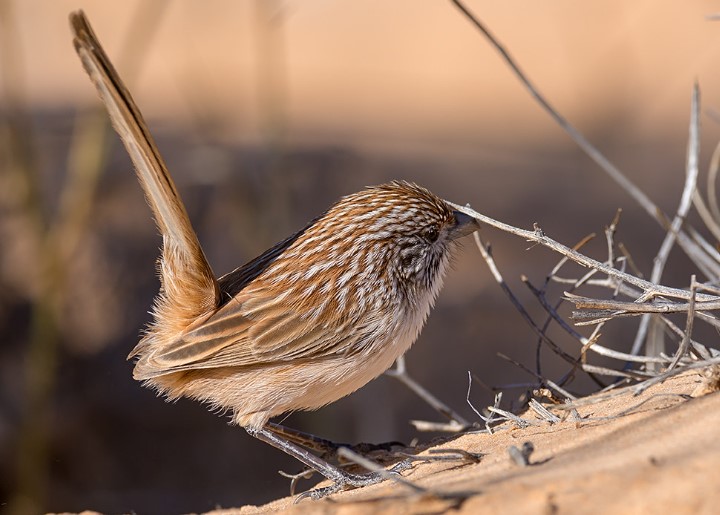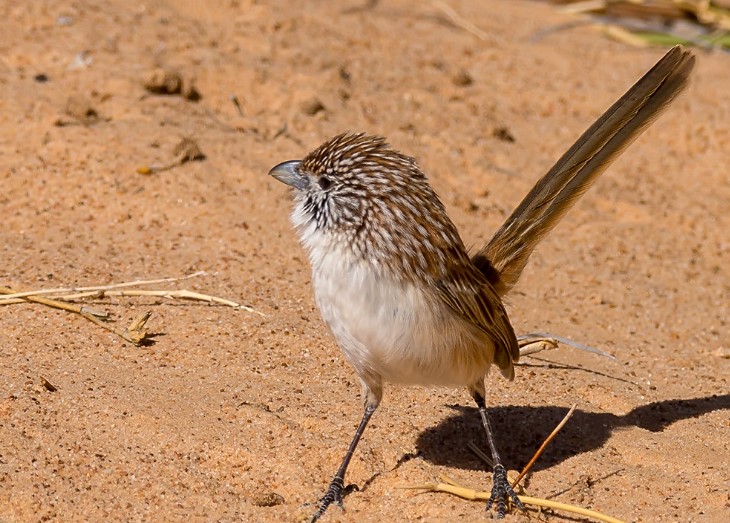Maluridae is a family of small grasswrens that includes the Eyrean grasswren. This bird is endemic to the arid regions of Central Australia and is cryptically plumaged. There is only one record of the Eyrean Grasswren from the 19th century until 1976. Among grass wrens, the Eyrean is one of the most widespread and abundant. In the Lake Eyre basin desert’s sand ridges, it inhabits hummocks of dune cane grass Zygochloa mixed with spinifex. This is an area seldom accessed by humans.
The Eyrean Grasswren lives in small communal groups of up to 10 birds. This species is difficult to flush because it is cryptic and hides in Z. paradoxa tussocks. Insects and seeds are eaten under and around clumps of cane grass, close to the cover, where they roost. At least half of its diet consists of seeds, most commonly from cane grass. This is why the grasswren’s short bill is similar to that of a finch. A hop-searching bird feeds by running around, bounding, and hopping from place to place, tails well-cocked and vibrating. It is not uncommon for them to perch low on Grevillea branches, cane grass, or other shrubs.
Birds maintain contact by chirping frequently and dashing, part-hopping, and part-flying to vantage points in shrubs or low trees to look around briefly or sing before diving back to the ground. Simpson and Strzelecki Deserts are home to the Eyrean Grasswren, a close cousin of the Striated Grasswren.
F.W. Andrews discovered the species around the Macumba River at Lake Eyre in 1874 and named it after South Australian Surveyor General George Woodroffe Goyder. The grasswren is also known as Goyder’s grasswren. An eyrean grasswren measures about 145-165 mm long. Sexes and populations differ slightly across the distribution, and some differences exist between them.
The male is cinnamon-rufous above, streaked white, and dusky beneath; the tail is slender, brown, with rufous edges. A faint cinnamon wash washes the flanks below. Dark black malar stripe; no brow. The eyes are brown. It has a thick bill and pale blue-grey feet. A deep rufous sash runs down the flanks of the female as well. At maturity, the markings are indistinct and duller. They hop between spinifex clumps (Triodia spp.) and within clumps of dune pea (Swainsona rigida) while foraging. In order to uncover food in the sand, it sometimes skips backward and shuffles its feet.
Grasswrens call high, cricket-like tseee and sreee when in contact; sharp zeet or zzrt when alarming. Birds’ songs are jumbled reels of cadences, pips, trills, and buzzes, with both sexes singing at the same time. There are a variety of distinctive melodies, including silvery cadences, pip trills, and staccato bursts. There is a strong and sharp sound to alarm calls, and they are louder than contact calls.
The nesting and breeding seasons last between August and September. Approximately one week is required for the female to construct a nest. The nest is a semi-dome-shaped structure made mainly of cane grass leaves and roots. It is located in the center of the tuft of cane grass. Generally, nests are well spaced, but some patches of good habitat may have more nests concentrated together.
It usually lays two swollen oval eggs about 19 x 15 mm, similar to those laid by Striated grasswren. The Eyrean Grasswrenis is found in the Spinifex and Canegrass dunes of the Simpson and Strzelecki Deserts, both in Queensland and the Northern Territory.








